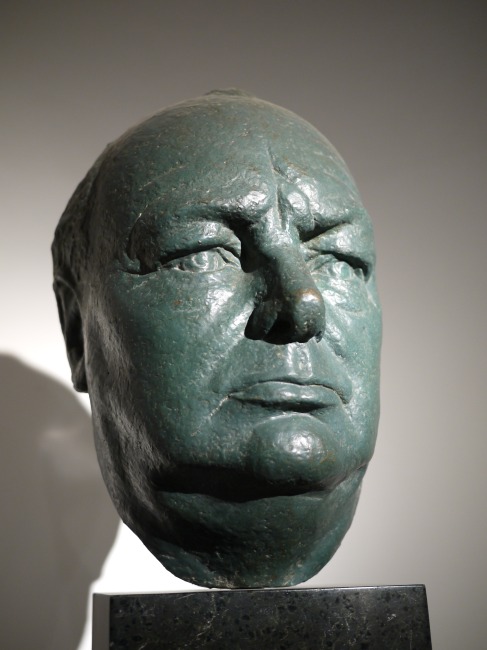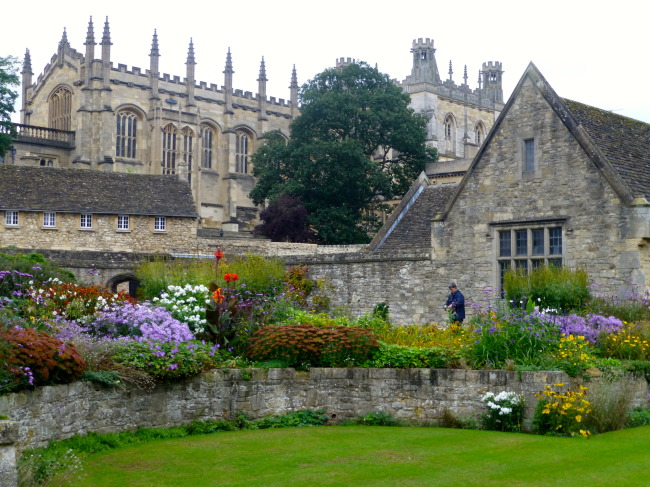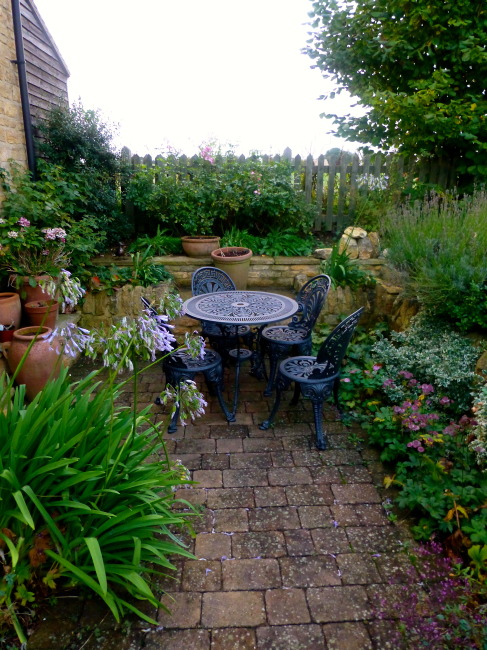
Chapter Thirteen: The Cotswold Blitz
October 2, 2013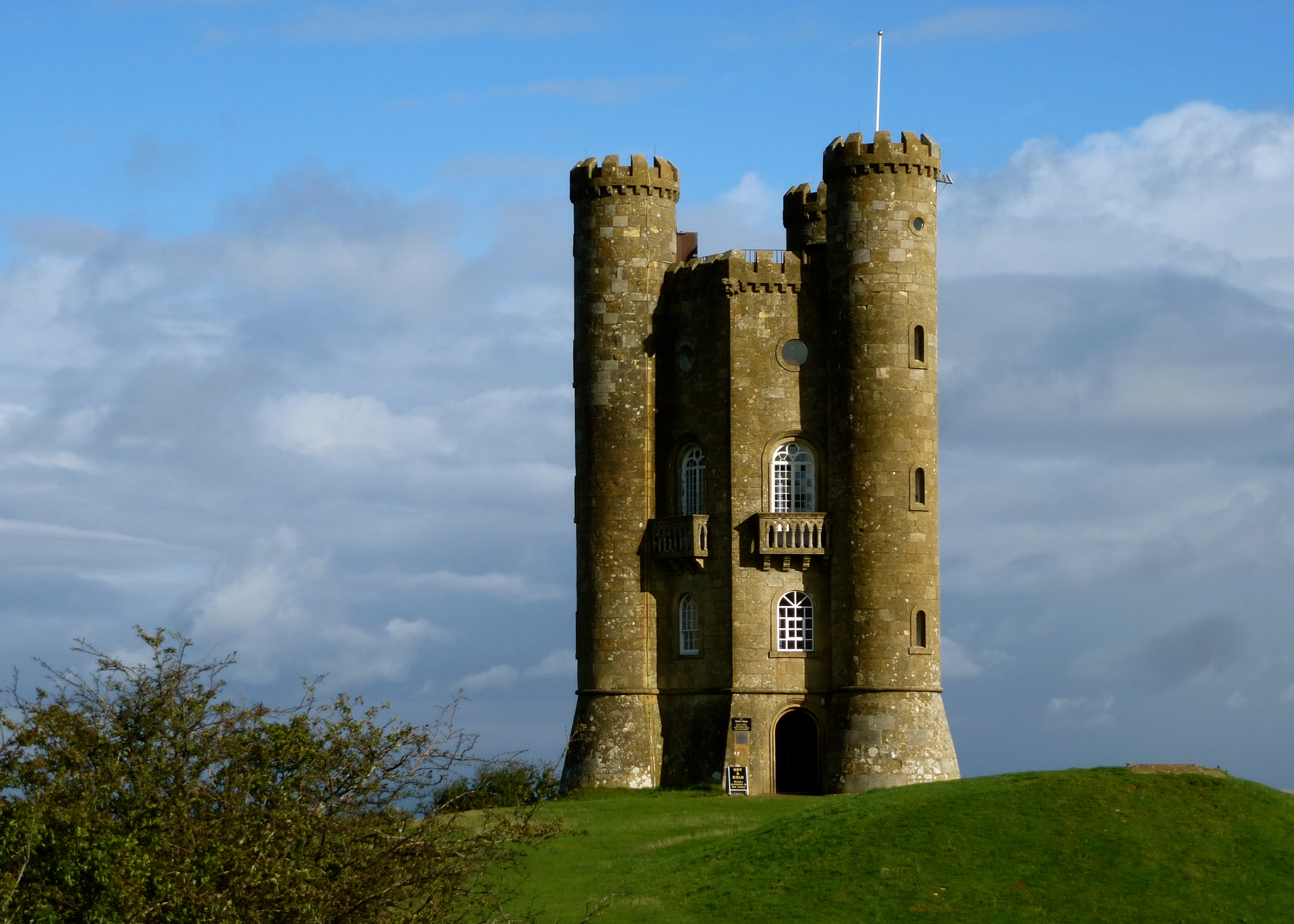
Chapter Fifteen: Towers, Castles, Gardens & Junk
October 4, 2013 Chapter Fourteen: Blenheim Palace & Oxford
Chapter Fourteen: Blenheim Palace & Oxford
Day Fifteen – Just Another Great Breakfast, Free Range Children, Quite Capable, Winston’s Birthplace, A Jenny Hat Trick, Where The Hell Is He Buried, Parking Problem, Visiting Hogwarts Academy, Can We Buy A Used Car Here, A Chipping Campden Picnic, “You Can’t Eat Here,” Ubu Redux and Eight Is Enough
The previous evening we had put in our breakfast order with Jane at the Bramley House.
 Breakfast was served at 8 a.m., and we started with a delicious fruit salad followed by eggs, sausage and bacon (best bacon of the trip).
Breakfast was served at 8 a.m., and we started with a delicious fruit salad followed by eggs, sausage and bacon (best bacon of the trip).
 We chatted for a bit with Jane and her husband, and it was time to set sail to see the mega palace where Winston Churchill was born.
We chatted for a bit with Jane and her husband, and it was time to set sail to see the mega palace where Winston Churchill was born.
 On the road to Blenheim Palace we saw an unusual sign that read “Free Range Children,” which reminded me of a travel board contributor, who once ordered “Free Range Children” at a Paris restaurant (actually it was a spell check problem). We assumed that it was a sign to watch out for kids at play and not a weird restaurant where patrons dine on barbecued Stevie.
On the road to Blenheim Palace we saw an unusual sign that read “Free Range Children,” which reminded me of a travel board contributor, who once ordered “Free Range Children” at a Paris restaurant (actually it was a spell check problem). We assumed that it was a sign to watch out for kids at play and not a weird restaurant where patrons dine on barbecued Stevie.
 It was about a 40-45 minute drive from Chipping Campden to Blenheim Palace, yet another UNESCO World Heritage site (really need to get going on that UNESCO card). It cost £22.50 for young Tracy to get in while the old folks paid the senior fee of £19.50.
It was about a 40-45 minute drive from Chipping Campden to Blenheim Palace, yet another UNESCO World Heritage site (really need to get going on that UNESCO card). It cost £22.50 for young Tracy to get in while the old folks paid the senior fee of £19.50.
We were there a little early (it opens at 10:30) so we strolled the grounds and took some photos.
 The grounds encompass something like 2,000 acres. We could have hopped on a miniature train to ride out to the Pleasure Gardens, which (among other things) contains a huge maze, but we’d already been lost in a maze on this trip, plus Blenheim Palace was about to open.
The grounds encompass something like 2,000 acres. We could have hopped on a miniature train to ride out to the Pleasure Gardens, which (among other things) contains a huge maze, but we’d already been lost in a maze on this trip, plus Blenheim Palace was about to open.
Promptly at 10:30 we walked inside the palace that was built to celebrate the Duke of Marlborough’s victory over the French in 1704. The Duke made sure that it was also a monument to Queen Anne, who helped secure the funds for its construction.
 One of the landscape gardeners who worked at Blenheim has one of the greatest names we have run across in our travels. His name was Capability Brown, who was obviously more than capable, and Capability made some major changes to the gardens at Blenheim.
One of the landscape gardeners who worked at Blenheim has one of the greatest names we have run across in our travels. His name was Capability Brown, who was obviously more than capable, and Capability made some major changes to the gardens at Blenheim.
The grandson of the 7th Duke is pretty well known, too. He is Winston Churchill, and before entering the State Rooms there was a section devoted to Churchill that we wandered through. In the first State Room (below) hangs a painting of one of its most famous residents.
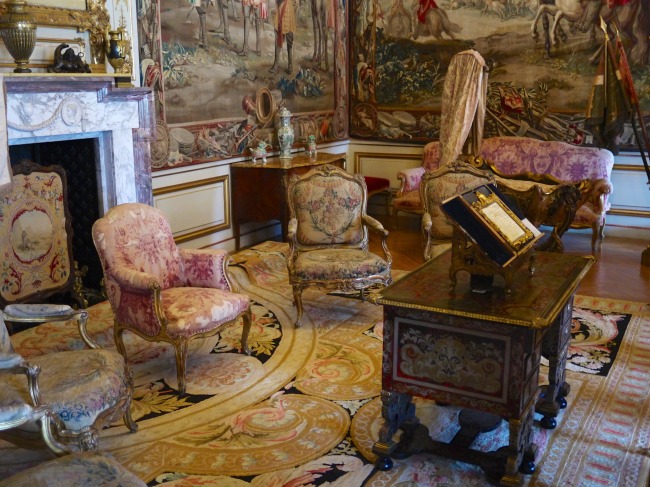 After the Churchill exhibit, we met up with our tour guide, yet another Jenny. This was our third tour guide with the name of Jenny, and she took us around Blenheim.
After the Churchill exhibit, we met up with our tour guide, yet another Jenny. This was our third tour guide with the name of Jenny, and she took us around Blenheim.
 The picture above is of Consuelo Vanderbilt, who was married to Winston Churchill’s older brother, Charles Spencer-Churchill (9th Duke Of Marlborough). It was an arranged marriage…he needed money, and her mother wanted her daughter to have a title. Vanderbilt had no interest in the duke. She was secretly engaged to an American, Winthrop Rutherfurd, but her mother finally forced her to marry Charles. At the wedding in 1895, according to wikipedia, “Consuelo stood at the altar reportedly weeping behind her veil.” The couple split up in 1906, and the marriage was finally annulled in 1921.
The picture above is of Consuelo Vanderbilt, who was married to Winston Churchill’s older brother, Charles Spencer-Churchill (9th Duke Of Marlborough). It was an arranged marriage…he needed money, and her mother wanted her daughter to have a title. Vanderbilt had no interest in the duke. She was secretly engaged to an American, Winthrop Rutherfurd, but her mother finally forced her to marry Charles. At the wedding in 1895, according to wikipedia, “Consuelo stood at the altar reportedly weeping behind her veil.” The couple split up in 1906, and the marriage was finally annulled in 1921.
 We walked through the Red Drawing Room (above).
We walked through the Red Drawing Room (above).
There were some exquisite tapestries in the three State Rooms that illustrated John Churchill’s (aka the Duke of Marlborough) victories at the Battle of Blenheim in 1704. The tapestry on the right (above) was given to Blenheim Palace by the English Parliament in gratitude for his victory over French forces.
 The ceilings were magnificent, as well. The ceiling on the left (below) is from the state Dining Room. The murals and paintings were painted by a French artist by the name of Louis Laguerre. He charged £500 for everything. Sir James Thornhill, who painted the ceiling of the Great Hall had originally been commissioned to do this room, but Sarah, the 1st Duchess of Marlborough disputed his fees. The ceiling on the right is in The Long Library.
The ceilings were magnificent, as well. The ceiling on the left (below) is from the state Dining Room. The murals and paintings were painted by a French artist by the name of Louis Laguerre. He charged £500 for everything. Sir James Thornhill, who painted the ceiling of the Great Hall had originally been commissioned to do this room, but Sarah, the 1st Duchess of Marlborough disputed his fees. The ceiling on the right is in The Long Library.
In the Long Library stands a statue of Queen Anne. The Blenheim Palace website states that the statue, “was commissioned by her friend, Sarah, the 1st Duchess of Marlborough, after the Queen had died. It is a very flattering portrait (yes, a portrait need not be a painting). In real life she was very short and very, very fat. Queen Anne had been pregnant 17 times but sadly none of her children lived long enough to become adults. All these pregnancies made her ill, and ruined her figure.”
 Also in the Long Library (designed by Sir Christopher Wren) stands a magnificent organ by ‘Father’ Henry Willis, built in 1891 to the order of the 8th Duke. This organ, acknowledged by many to be Willis’s finest organ and the largest organ in private ownership in Europe, has four manuals and pedals, 2300 pipes and 53 speaking stops.
Also in the Long Library (designed by Sir Christopher Wren) stands a magnificent organ by ‘Father’ Henry Willis, built in 1891 to the order of the 8th Duke. This organ, acknowledged by many to be Willis’s finest organ and the largest organ in private ownership in Europe, has four manuals and pedals, 2300 pipes and 53 speaking stops.
 The family still lives at Blenheim Palace, but they didn’t come out to greet the California royalty who had traveled so far to see them. The private apartments were closed on this day, too.
The family still lives at Blenheim Palace, but they didn’t come out to greet the California royalty who had traveled so far to see them. The private apartments were closed on this day, too.
We saw a dining room that was fit for a king…or at least a Duke. The indoor part of the tour concluded in the Palace Chapel. There we saw the tomb and sarcophagus of the Duke Of Marlborough. 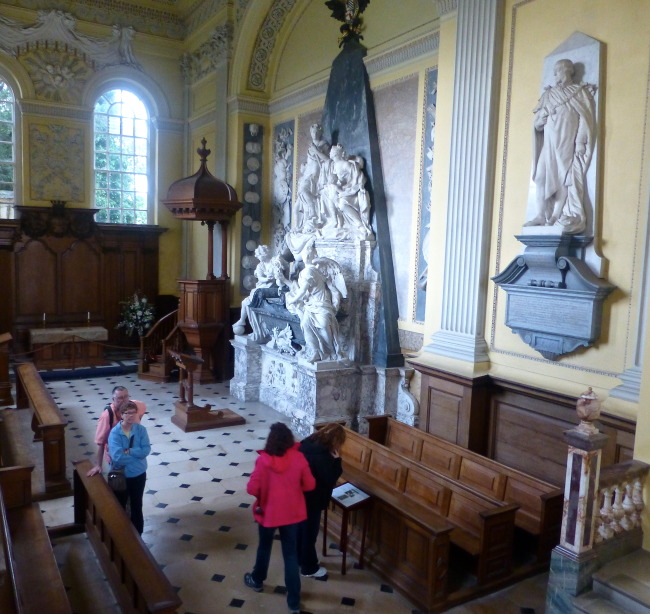 We then ventured outside to look over the vast grounds from the Water Terrace, which encompass something like 2,000 acres. Blenheim is an expensive, but very worthy, excursion.
We then ventured outside to look over the vast grounds from the Water Terrace, which encompass something like 2,000 acres. Blenheim is an expensive, but very worthy, excursion.
We had been told that Winston was buried very near Blenheim, and we could walk to where he is buried, but then someone else told us he was buried in the nearby town of Bladon, just a short drive away.
As we exited Blenheim, we immediately saw a sign that said “Churchill’s Grave” in Bladon, which was the direction we were traveling. Well, we kept going…and going…and going. There was no other sign and we were past Bladon. Kim turned the car around (carefully…you never get completely adjusted to the wrong way driving), and we headed back toward Bladon and saw no sign at all for Churchill’s grave as we drove by.
 Oh well, we gave up on Churchill’s grave (had to get a photo off the internet instead to see what we missed) and drove the short distance to Oxford. It took us almost as much time to find a place to park in Oxford as it did to reach this town, but finally we found a spot not too far from our next attraction.
Oh well, we gave up on Churchill’s grave (had to get a photo off the internet instead to see what we missed) and drove the short distance to Oxford. It took us almost as much time to find a place to park in Oxford as it did to reach this town, but finally we found a spot not too far from our next attraction.
We walked until we were at a pedestrian walking street (Cornmarket Street), stopped and had a pasty at the Cornwall Pasty Co. It was a tasty pasty with Beef and Stilton, which we ate along with some calorie-laden potato wedges. We didn’t care. By now we had walked more than 110 miles in two weeks (hell, we could have done the entire Cotswold Walk).
Next stop was Christ Church, referred to as “The House” by its members.
 The gate tower was designed by, who else, Sir Christopher Wren, and we were told that the church bell rings 101 times at 9:05 p.m. in honor of the original Christ Church scholars.
The gate tower was designed by, who else, Sir Christopher Wren, and we were told that the church bell rings 101 times at 9:05 p.m. in honor of the original Christ Church scholars.
By the way, the name of the bell was once called “Mary” and then changed to “Great Tom,” because, I assume, all Toms are great.
Speaking of great, The Great Hall was closed for an event that evening, but we were able to gaze inside and take a couple of photos of the room that was replicated in a film studio for the Harry Potter movies (I think some of the scenes were shot here, too).
 You could almost see young Harry and the Hogwarts’ students dining there, since it was all set up for dinner.
You could almost see young Harry and the Hogwarts’ students dining there, since it was all set up for dinner.
We once again lucked into a guided tour that was about to start up at the Christ Church Cathedral, built about 800 years ago.
An American ex-pat took us on a 25-minute tour and told numerous stories including some about Alice in Wonderland and stained glass windows with ships in them.
I think one of the stained glass windows from the 19th century located in one of the chapels has a likeness of Alice’s sister, but by this time I was getting my stained glass windows mixed up, but these were beautiful, too.
They were also having organ practice that day, and a few of the organists were a tad off key, but it still sounded great. However, the big clock on the wall was literally telling us to get back to the car before our time expired.
As we walked back to the car we passed by Carfax Tower. I asked Mary if she wanted to get a quote on a used Hyundai, and she explained that this Carfax is the only part of St. Martin’s Church (built in the 11th century) that is still standing (she really does read my pre-trip notes). We also walked by a “Tom” that was old.
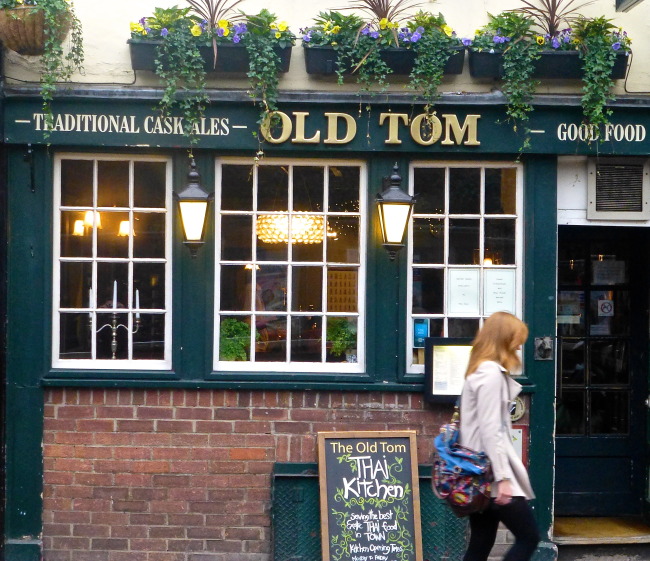 We drove back to Chipping Campden, where we first parked a little outside of town so we could take some photos of those cool thatched roofs.
We drove back to Chipping Campden, where we first parked a little outside of town so we could take some photos of those cool thatched roofs.
Fortunately none of the neighbors told us to, “Get off my lawn!” Not that we could see a lawn to get off of, anyway.
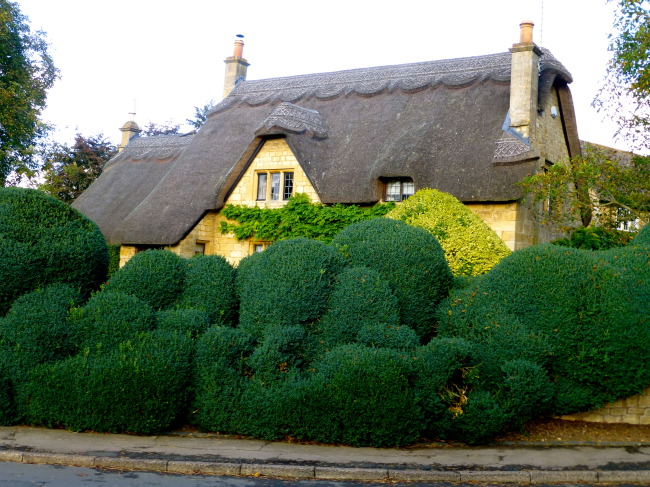 Our next stop was at the French bakery (the one that our waiter from the previous evening owns) to pick up some bread. The Chipping Campden High Street contains many superb Cotswold stone buildings, built by wealthy merchants between the 14th and 17th centuries. In 1970 the High Street and much of the rest of the town was officially designated a conservation area to preserve the ancient town for centuries to come.
Our next stop was at the French bakery (the one that our waiter from the previous evening owns) to pick up some bread. The Chipping Campden High Street contains many superb Cotswold stone buildings, built by wealthy merchants between the 14th and 17th centuries. In 1970 the High Street and much of the rest of the town was officially designated a conservation area to preserve the ancient town for centuries to come.
Being equal opportunity shoppers, we then headed over to a wine and cheese shop for some, well, you know.
Chipping Campden’s most famous monument is the Market Hall (below right), erected in 1627 in the center of the town, to provide shelter for the local produce market. Back then, it was an elegant shopping hall for the townsfolk who’d come here to buy their produce. In the 1940s, it was almost sold to an American, but the townspeople heroically raised money to buy it first, then gave it to the National Trust for its preservation. The World War I Monument was built in 1929.
We strolled about town for a little bit more before heading back to our abode.
 The skies had cleared, so we put on our jackets and had a delightful picnic at a cute table in the Bramley House backyard.
The skies had cleared, so we put on our jackets and had a delightful picnic at a cute table in the Bramley House backyard.
After eating our cheese and bread (with a little vino), it was now time to eat some more. We walked into town and scoped out a few restaurants. The menu at the Lygon Arms Hotel looked good, so we wandered inside. There were only about two tables occupied, so we thought we were in good shape. “Could we get a table for four, please,” I inquired politely?
“Are you staying here,” the surly waitress asked in a rather unpleasant tone? “No, we’re not,” the still-polite gentleman from California replied. “Well then, you can’t eat here,” said the nastiest server this side of the Atlantic. Hey, that’s my story and I’m sticking to it.

Instead we walked down to the Eight Bells (photo below and above from website), where we already had reservations for our last night. The Eight Bells is an historic Cotswold Inn built in the 14th century for the stonemasons who built St. James Church. It also housed the eight bells that eventually hung in the church tower. We were worried, because this place was pumping on a Thursday night, but the cheerful hostess said for us to wait just a minute and quickly secured a table for us. Take that stupid Lygon Arms! Yes, I’m getting to be a grumpy old man.

The first thing I saw on the menu was Ubu on tap. My grumpiness quotient was now lowered significantly. I started with a very nice mushroom/corn soup and for my main course had pasta with goat cheese and basil pesto (as did Kim). Mary tried the home-made Prime Lamb, Garlic & Oregano Burger topped with Tzatziki (a Greek sauce), served in a toasted Pita with Hand-cut Chips and a Halloumi Cheese (very popular in Greece) & Olive Salad garnish.
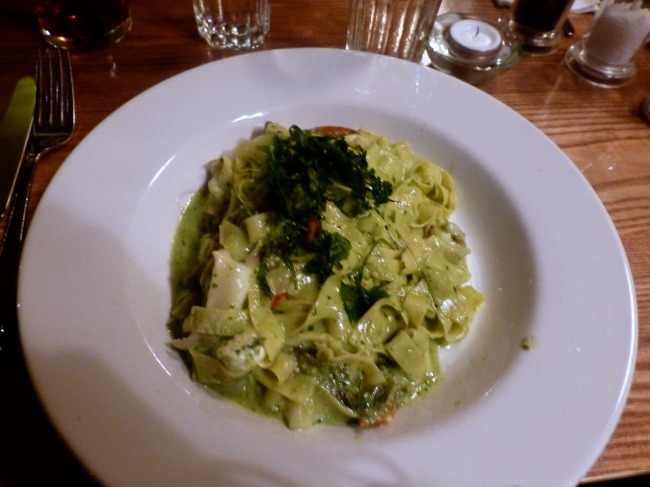 Tracy opted for the Pan-fried Medallions of Prime English Pork Fillet with a creamy Stroganoff Sauce and Basmati Rice, served with Seasonal Vegetables.
Tracy opted for the Pan-fried Medallions of Prime English Pork Fillet with a creamy Stroganoff Sauce and Basmati Rice, served with Seasonal Vegetables.
Dinner was terrific and our server was charming. I was too full for dessert, but vowed I would not overeat the next night because something on the menu had caught my eye. We walked off this nice dinner with a stroll through lovely Chipping Campden and decided to wander over to see how crowded the evil Lygon Arms was at this time. Walking into the dining area, there still were a number of empty tables. Maybe the waitress just told everyone to take a hike that night.
It was back to the Bramley House where we would need a good night’s rest. Our plate was extremely full for our final full day in England for the Maitai Four.
 Tomorrow, not only would we see sweeping vistas of the English countryside from a famous tower, visit some cute little towns, stop in another castle and tour a funky house that contained some more incredible gardens, but I would also have the dessert that changed my life (well, at least until I find another one on our next trip).
Tomorrow, not only would we see sweeping vistas of the English countryside from a famous tower, visit some cute little towns, stop in another castle and tour a funky house that contained some more incredible gardens, but I would also have the dessert that changed my life (well, at least until I find another one on our next trip).
Next: Day Sixteen – Tower Trouble, A Stanton Drive-By, Fountain Penned, An Unscheduled Cotswold Walk, Below Parr, Give My Regards To Broadway, A True English Gentleman, I’m Melting, Mind Your Manor, One Man’s Junk Is…, Gardens Galore, The Last Cute Town, What Time Are We Leaving Again and My Sticky Love Affair Heats Up





